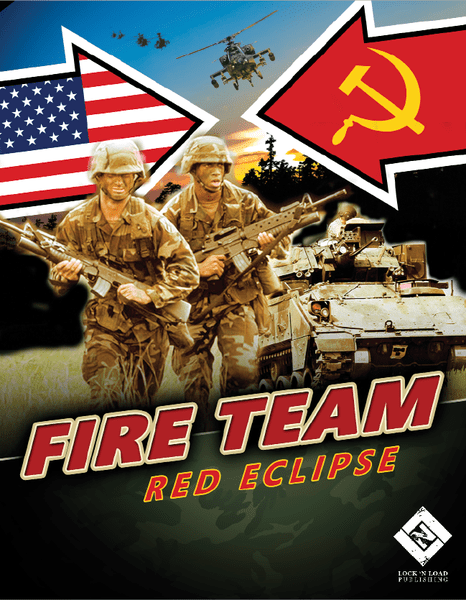You know how we at The Players’ Aid love a good Tactical wargame. We love the small personal scale of squads versus squads and find that the games always tell a great narrative along with being fast playing, furious and more often than not very bloody. When we attended WBC last year, we had the fortune of meeting a real tactical aficionado in Steve Overton. We didn’t get to spend a lot of time with Steve but he did show me his upcoming tactical game Fire Team: Red Eclipse coming from Lock ‘n Load Publishing and I have been left wanting to know more. So I contacted Steve and he was very gracious in answering my questions on the upcoming game.
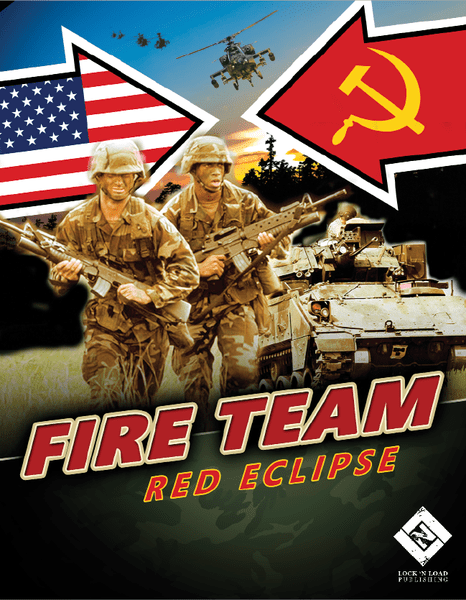
Grant: Steve first off please tell us a little about yourself. What are your hobbies? What’s your day job?
Steve: I grew up in Wyoming, bought my first wargame in 1971. It was Stalingrad from Avalon Hill. The third game I bought was Panzer Blitz and I’ve been doing tactical gaming ever since.
Because I have issues with my legs I can’t explore the Rocky Mountains any more. No fishing, hiking or photography off trail like when I was younger.
Now I write for fun. I have a book that is ¾ done. I also enjoy researching and creating scenarios for both board game and computer tactical game systems.
Grant: How did you get into game design? What do you love most about it?
Steve: I bought Panzer Blitz and it had different types of battles (scenarios). I played them all through and then thought about the actions I’d been reading about in books. I made my first scenario less than a year after I bought Panzer Blitz. I’ve continued to make them to this day. I like to test my own skill game level against the actual historical results.
I feel that if I can get the terrain and OOB as close to historically accurate as possible you get an insight into why that battle went the way it did. I really strive for that ‘boots on the ground’ feeling.
Game design is new to me. I only designed this game series because I was sick and tired of the 400+ pages of rules in ASL. I wanted something that was easier but had the same immersion. At the time I started the Kontact Now (KN) series there weren’t a lot of tactical game series published like there are now, and when I played West End Games’ Fire Team that system struck me as being what I was looking for. Unfortunately, West End didn’t continue the series. So, eventually I did.
Grant: What is your design philosophy?
Steve: I want ‘boots on the ground’ immersion. For me that means chaos gaming. I don’t create chess games. Real life situations aren’t about ‘I take a turn, you take a turn’ (IGUG – I Go, You Go).
Chaos gaming to me means as many uncontrolled events as I can possibly include in my designs. Random Chit Pull, variable number of impulses per turn, unknown tactical events, scenarios not having specific ending turns, Fog of War, etc.
Grant: What do you find most challenging about design? What do you do really well?
Steve: I didn’t start off to be a game designer. Like most, in my opinion, I was simply looking for the game I wanted, but it didn’t exist. That’s when a friend told me to, ‘make your own game if you don’t like theirs’. So, I did.
The most challenging thing for me is writing the rules. In my mind I know what they should be, but writing them down legibly and understandably however is the challenge.
My single strength I believe is that I find the odd situations that draw people in. I am able to balance most of my scenarios within 2 playthroughs. So, when I give them to playtesters they often need no tweaking.
Grant: Why do we need another tactical series? Aren’t there enough already?
 Steve: This game series is not like other tactical game series, from the reaction to those that have played it, and my own intent and development of specific game mechanics, it’s very different from the others. If it wasn’t, there would be no need for it. I was into computer wargaming for 2+ decades. I started the HSG design team for the Combat Mission series and we did dozens of scenarios for that system. Then I worked on the teams that created Panzer Command Ostfront and Flashpoint Campaigns: Red Storm.
Steve: This game series is not like other tactical game series, from the reaction to those that have played it, and my own intent and development of specific game mechanics, it’s very different from the others. If it wasn’t, there would be no need for it. I was into computer wargaming for 2+ decades. I started the HSG design team for the Combat Mission series and we did dozens of scenarios for that system. Then I worked on the teams that created Panzer Command Ostfront and Flashpoint Campaigns: Red Storm.
I did the expansions for Fire Team with West End Games back in 1989. I did the UK, W. Germans, Polish, Czech and East Germans. Sent it to them and started on the WWII part of the series. Within 6 weeks I got my work back with a note that said they no longer sold wargames. At about that same time the board wargaming community collapsed. AH, SPI, GDW, etc. all gone within the blink of an eye.
I left and went to computer wargames. It was only one day when my grandson, whose initials are KN – the series initials, pulled out the box and we played what I had done years ago that the interest in the series grew. By then board games were back so I pulled the game out and started tinkering again. But I’d been gone from board wargames for more than 2+ decades so I bought a copy of at least one game of all the tactical series that had been created since I left. Looking to see if there was one that I could be happy with.
It wasn’t there, so, I took the best parts of each series and incorporated those into my own series. This game series covers from WWII through 20 years into the future. With minimal rules, extreme immersion, intensity rarely encountered on a map board, and realistic chaos.
Grant: What is different about Fire Team: Red Eclipse?
Steve: The major difference between Red Eclipse and all the rest is the blend.
Take these game features:
Command Points
Random Chit Draw
Variable Impulses per Turn (generated by the status of the Leaders on the map)
Variable Turns per Game
Tactical Event Cards
Three dice combat resolution system (3D6)
Throw it all in the blender and out comes a very unique playing experience.
Grant: Why did you want to design this game? What was your overall design objective?
Steve: Like most that design games I was looking for the game series I wanted to play. It wasn’t out there; I wanted the continuation of the Fire Team games that Jon Southard would have created. So, I contacted Jon and discussed it with him until he was probably hoping my email would stop working. He gave me his blessing after countless idea swaps and we were off and running.
My overall goal was for KN to cover all the tactical situations I could create as a scenario designer. If I could read about a situation I wanted to be able to produce that in my board game. I can do that now.
Grant: What game systems did you draw on to inspire your concepts?
Steve: I looked at all the tactical game systems. However, ASL, Fire Team and Combat Commander were the three that influenced KN the most.
Of that group the one that surprised me most was Combat Commander. I HATED cards in wargames, especially card driven games. The first time I’d seen or heard of the series was at a friend’s house in Round Rock, Texas. He showed me the game and I had just two words for him, “Not interested”. As I left he threw the box in my truck and the rest is, as they say, history.
Chad and Kai Jensen’s game series jolted me to reality and I bought all their games and expansions. I thought this could be the game series I was looking for. After a couple of tournaments and lots of play the luster wore off, just a bit. Enough for me to know that Combat Commander wasn’t the series I could fully commit to. What it actually did happen to be though was the catalyst that opened my eyes to a different way of showing Fog of War. Which, IMO, is where computer games shine and board games suffer. Chad and Kai had unlocked Fog of War for me. For that I owe them both a huge debt of gratitude.
Grant: What era does Fire Team: Red Eclipse cover? What elements are important to model in a game covering modern warfare?
Steve: This first game of the series covers West Germany – Cold War Gone Hot in 1989. That was the first year that NATO thought it could win a conventional war with the Warsaw Pact and as such, a perfect place to start.
The entire KN game series, covering from 1937 through 20 years in the future, was already created before I even approached a publisher. So, all the technology advances, etc. from WWII through modern combat today were tested. It all works seamlessly. Nothing was cut short. Each system of tactical combat was made as accurately as we could. For the series I believe the most important part was making the Infantry/Artillery/Combat Air Support models work equally well.
I felt it was important to show how technology had advanced from 1937 to 1989. Not just infantry but armored vehicles as well. In WWII combat is uncomplicated in comparison to today’s combat, in some respects, in other respects it’s barely changed at all. I wanted to get the complicated end right with Red Eclipse. If I can do that the rest should be easy.
That’s my story and I’m sticking to it…

Grant: How much did you interact with Jon Southard, the designer of the original Fire Team game? How was his experience helpful to you?
Steve: Jon and I communicated often in the beginning. He was unaware that I had done an expansion all those years ago for West End Game’s Fire Team. In my opinion Jon Southard is the best wargame designer, as well as being one of the nicest people in our community. I would talk about changes I’d like to make and he was always positive. In the past couple of years I’ve pretty much gone my own way, however I always keep his goals and direction in mind when I do anything to either this game or the series.
I could spend untold hours just talking with Jon. He’s an amazing designer. There is no end to what I feel I could learn from him. The entire process of sharing ideas with him was extremely helpful to me.
Grant: What did the art and graphic design talents of Shayne Logan bring to the table?
Steve: Shayne and I have been friends for years. Back from the days of Flashpoint Campaigns: Red Storm. I really like his rendition of my maps in both games. He brings a level of immersion that is amazing.



Grant: How does the design bring together mechanics to represent the OODA Loop, training and experience of military organizations?
Steve: The OODA Loop is a natural outcome of training, and the reaction time of a unit, of any size, can change the outcome of the situation.
What I did for KN was twofold. Training and Leadership. The Training part of the equation was from the most fluid example (American training and implementation of orders) to the most rigid (Soviet/Russian training and implementation of orders). The training styles of most of the world’s militaries were set in WWII. For both the US and Soviets this is true. The US, because they were normally loath to take high casualties, their orders needed to make sense to the ‘citizen soldiers’. The Soviets because they had few radios and were expected to follow written and/or oral orders to the letter.
What this means in practical game terms is the opportunity to impact the way the engagement is guided. The CP chits are determined the same for everyone.
At the start of each turn the status of the leadership for their side determines the amount of CP’s they get.
• 1 per Infantry Leader
• # equal to the Infantry Leader Bonus
• 2 per Unbroken Armor Leader
• 1 per Broken Armor Leader
As an example, both the US and Soviet player have 7 CP’s this turn.
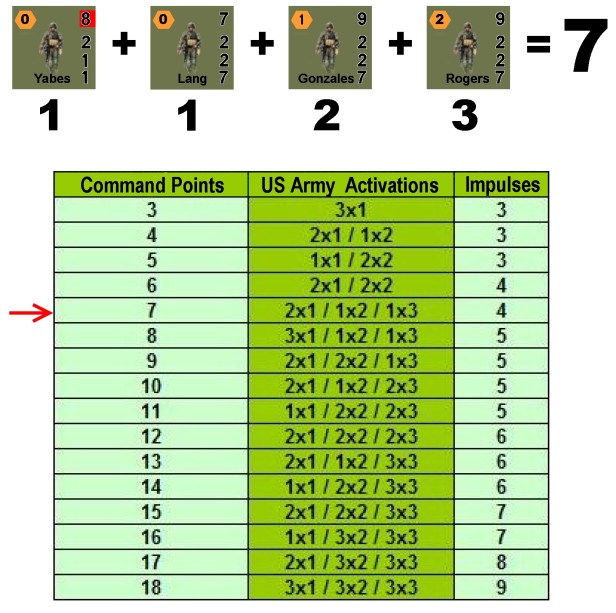
The Americans will have 7 Command Points for the current turn. A Broken Leader gets a single CP, a Zero Command Bonus Leader gets a single CP, a 1 Command Bonus Leader gets 2 CP’s (1 for being a Leader and 1 for it’s Command Bonus) and a 2 Command Bonus Leader gets 3 CP’s. (1 for being a Leader and 2 for it’s Command Bonus).
The Command Point Chart shows that 7 Command Points give the American player 4 impulses for the turn. 2 – One CP Chits, 1 – Two CP Chit and 1 – Three CP Chit for a total of 4 CP chits available for Random draw.
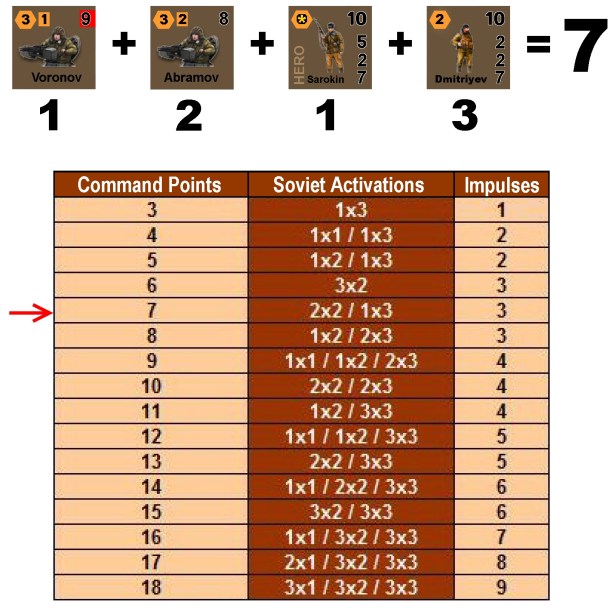
The Soviets will have 7 Command Points for the current turn. A Broken Armor Leader gets a single CP, the Armor Leader gets 2 CP’s (2 for being an Unbroken Armor Leader), a Hero Leader gets a single CP and a 2 Command Bonus Leader gets 3 CP’s. (1 for being a Leader and 2 for it’s Command Bonus).
The Command Point Chart shows that 7 Command Points give the American player 4 impulses for the turn. 2 – One CP Chits, 1 – Two CP Chit and 1 – Three CP Chit for a total of 4 CP chits available for Random draw.
NOTE: The same CP’s for different nations will more than likely NOT give the same number of Activations and Impulses.
All other nations have either been trained by these two major military lines of thought or fall somewhere between them. Command Points are set by these training tendencies, which influence their SOP, their reaction times, etc.
The Tactical Event Cards, each side gets a deck of 50, has the most often used actions by that military organization. Their tendencies are built into the deck. You will play that military organization like they normally operate because those are the choices you will be offered.
Grant: How does the system treat Command and Control of tactical combat units?
Steve: Command and Control is the realm of the in game Leaders.
Command is shown through the level of operational leadership on the map. The state of fear each leader is operating with is reflected in the amount of Command Points they generate. Broken/disrupted leaders normally generate less command points than those leaders that are operating without fear.
Control is done using leadership values and command radius assigned to each leader. Leaders use their leadership value to activate a number of units within that radius. There are three leadership value levels in the series; 0, 1 and 2. Leaders can activate any unit within their command radius.
Units outside of a leader’s radius must activate individually. So unlike some games that have leader activations, in the KN series if you lose all your leaders each side will still get at least 3 Command Points to give them a minimal command response. This is to represent sub-unit leaders not shown on the map. Leader counters on the map represent those leaders that have a large positive or negative impact on units. Other leaders that are simply competent, for the most part, aren’t shown with actual counters on the map.
Grant: How do you replicate the random events that tend to happen in small unit actions?
Steve: The game series uses two methods: Tactical Event Cards and the 3-dice system.
Overall the series has more than 30 different possible tactical events. Red Eclipse uses 22 of those possible. In this specific game each side, USA or Soviet, has the same type of tactical event cards but different amounts for certain cards.
I took several months to read through various small unit actions, as well using my own personal experience from my time in the US Army, to come up with a universal set of tactical event cards. Events that could be considered normal actions by at least 1/3 of the world’s military organizations, and that cover a 90+year period. The names for the cards were actually assigned when I was working on the Vietnam time period, so some of them may seem a bit odd but we felt they were representative enough to keep.
The Tactical Event Cards used in Red Eclipse are:
Ambush
Artillery Mission
Boresight
Close Air Support
Command Coordination
Confusion
Determined Attack
Determined Defense
Double Time
Exhaustion
Experience Level Up
Experience Level Down
Grenade Attack
Heavy Patrolling
Hero
Infiltrate
Mines
Morale Wavers
MRL Attack
Rally
Rapid Fire
Reaction
Certain events have either come out of favor or do not apply to this first game of the series. Events such as Human Wave Attack and Bayonet Attack have, for the most part, been relegated to the past. Other games in the series will feature different cards that represent the tactics and events for their appropriate time period.
Grant: How are Tactical Event Cards used? Can you give us a few examples of these events and show us a few of the cards?
Steve: In Red Eclipse the Tactical Event Card decks are about equally divided between offensive cards (for example: Close Air Support Mission) and defensive cards (for example: Exhaustion, stop an opponent’s movement order).
However, other games in the series will have asymmetrical Tactical Event Card decks, specially designed to highlight the organizations capabilities for that time period as well as depending on the historical tendencies of that nation’s military forces.
During normal play each player draws and maintains a hand of 4 Tactical Event Cards from their deck. These cards may be played at any time during the Action Phase. Even before a CP chit is drawn to start an impulse or before any unit activations have taken place.
Tactical Event Cards may be played at any time during the turn. Activation of a Tactical Event Card isn’t restricted to the player whose impulse it is. They may be played at anytime during any impulse. They may be used in combinations or even to counter your opponents Tactical Event Card play.
They add a degree of tension, chaos, intensity and Fog of War not found in other games. The play of a single Tactical Event Card may, and often does, change the momentum of a game.
The text on each card is designed to be self-explanatory; players won’t need to look anything up in the rulebook.

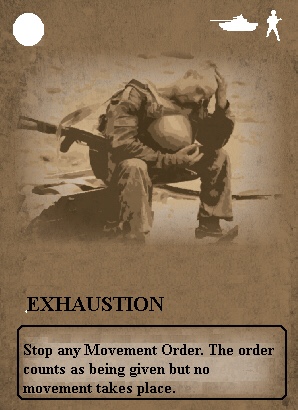



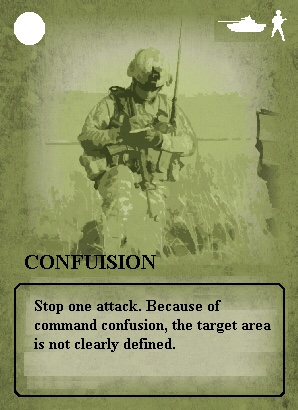
Grant: The game uses chit draw with orders. How does this work and why is this important to the realism of the game?
Steve: Random chit draw brings uncertainty to the game. That’s how combat is. It’s not one side moves then fires all their units in an orderly fashion. No matter how little the bites, combat is still not orderly.
Command Point Chit’s have values of 1, 2 or 3. Once a Command Point Chit has been drawn you can do whatever you like with the activations equal to the number on the chit. But you almost never have enough to do ‘everything’ you’d like.
To me this is realistic. I never experienced a single time when a leader could make happen everything they wanted. There were always priorities. Some of them very pressing all at the same time and they would have to make tough choices. I believe you will feel that in this game and throughout the entire series.
Grant: How important are Leaders on the board? How can their ability deteriorate over the course of a scenario?
Steve: Leaders make 85% of what happens on the board work. With a Leader you can form fire groups, call for Artillery or Close Air Support, use Support Weapons, adjust firepower, modify To Hit attempts, repair weapons, rally troops, etc…
As you saw in Question 16, as the leadership deteriorates during play so does the Command and Control for that side’s forces.
Grant: How important is weaponry to your design? How much research did you do on each weapon system to ensure accuracy?
Steve: Weaponry is very important in any tactical game, no less so in Red Eclipse. The game series covers from 1936 through 20 years in the future. The infantry firepower are subjective values. So, I took the most powerful infantry weapon from 1936 to now. That turned out to be the MG42 with a tripod. I then wrote a formula where I compared bullet size, cyclic rate of fire and feed mechanism. Then I set the value that I tested to get the intermediate value from the bottom of the scale – bolt action rifles, to the top of the scale – MG42.
Vehicles were more finite values for the older models or those that have been in combat. I took the strongest armor values for the front/side/rear on the hull and turret. I also used given penetration values for different range bands. Things like optics, smoke generation, composite armor, passengers, thermal sights, SPAA, SPAT, vehicle size, Infantry firepower of the gun, if the vehicle has more than one weapons system, etc. were all factored in.
Each vehicle, helicopter and to some extent On Call Artillery and Close Air Support are all individual and unique. Most of the information about each vehicle is on a separate data card.
Examples of the Data Cards.
The main American armor.
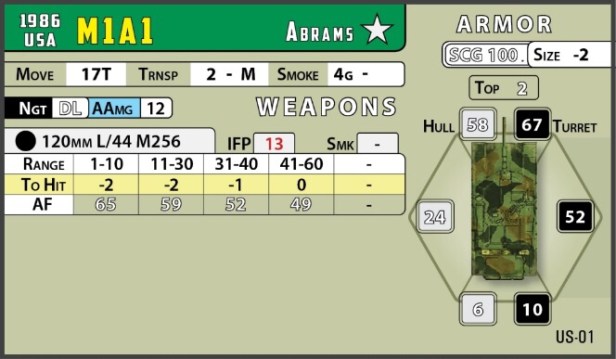
The Russian workhorse.
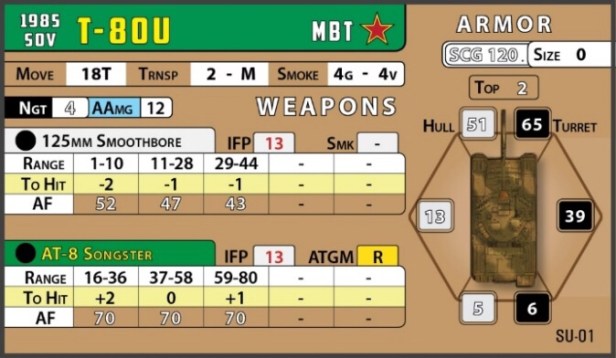
Grant: How does Combat work? How are the dice different than other tactical games? What element of realism does this add to the game?
Steve: Fire combat is broken into 3 levels to represent the 7+ decade time frame the game system covers. This time period starts with most nations having squads equipped with bolt action rifles and encompasses up to the current day and beyond with fire teams armed with assault rifles.
To show that evolution the game uses 3 six-sided dice. A white, black and red D6.
The base values for weapon firepower through time sometimes end up being exactly the same. So, how to tell the difference between bolt action rifles and automatic weapons? By using the 3-dice system.
White printed firepower values, usually bolt action single shot weapons, add a white die to the attack. Black printed firepower values, usually automatic weapons, add both white plus black dice to the attack. Red printed values, explosive ordnance, add all three white, black and red dice to the attack.
The highest color factor in the attack dictates which dice level to use.
For instance a German Squad armed with bolt action rifles attacks using their white printed firepower value, so only the white die is added. If however they have an MG support weapon with a black printed firepower value the entire attack would use the white + black dice for resolution.
This shows the evolution of not only the size of maneuver elements on the battlefield but the technology advance from bolt action weaponry to modern assault weapons and why automatic weapons were so important early on in that transition.
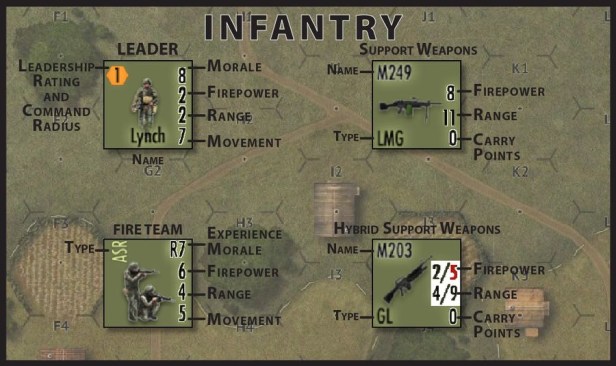
The 3 dice system can produce a random event on any die-roll. All three dice are used for every roll and if the result is a double or triple, a random event could occur. Depending on the specific situation at the moment of the die roll. Most of the time only one or two of the dice is used for the resolution of whatever action is taking place. Triple die rolls are for those times when things have gone completely pear shaped and you have to react at a moments notice. The triple events are either friendly or detrimental to both sides depending on your point of view at the time.
This has the effect of having some random events controlled by the player, in the form of Tactical Event Cards, as well as triple die rolls which create events outside the control of the player.
Grant: Can you show us a few examples of the counters? What are the different numbers and symbols on the counters mean?
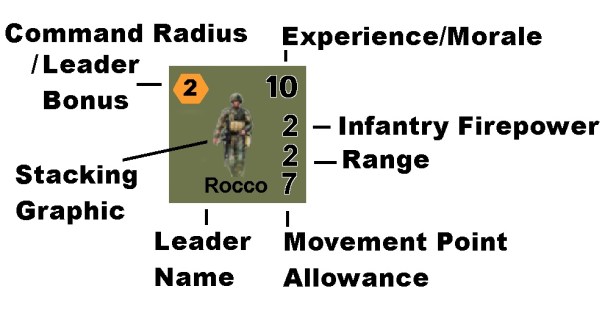
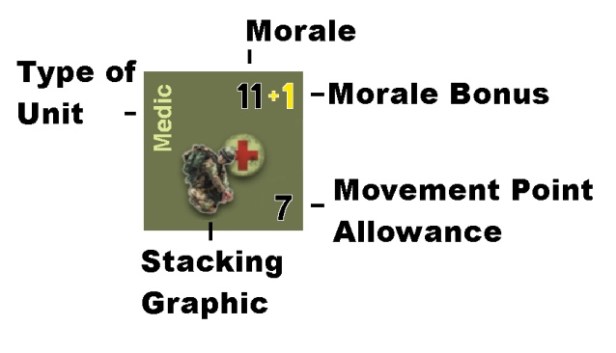
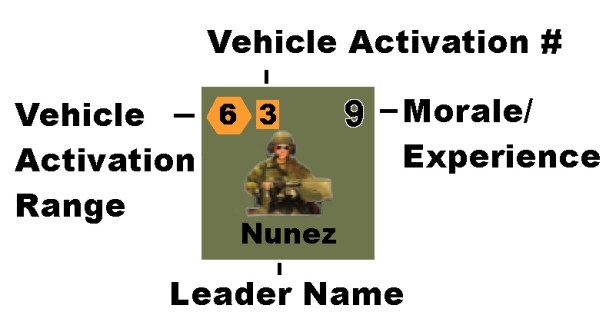
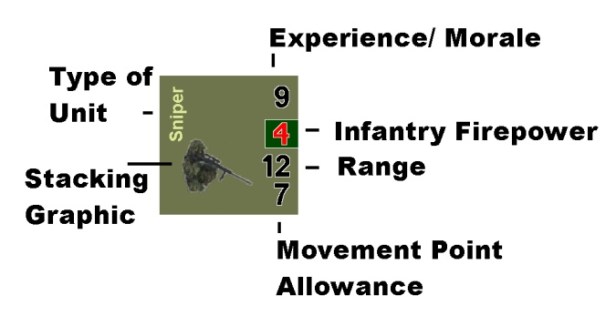
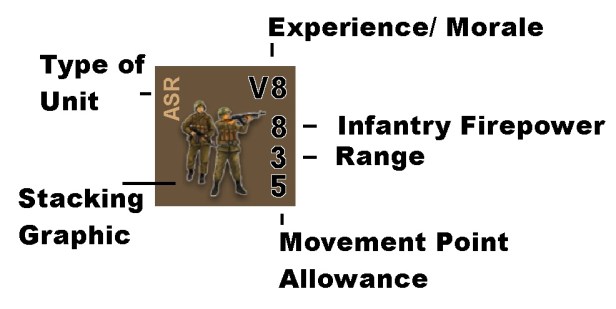
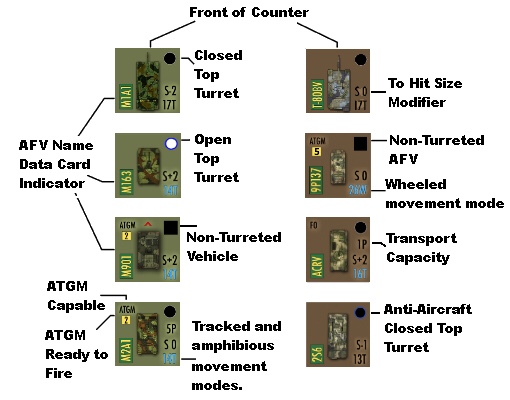
The Nunez Armor Leader counter is named after my grandson. He’s the main reason we are all here discussing this game now.
Grant: What is the schedule for the games release?
Steve: At the moment we are on tentatively on the schedule for mid to late summer.
Grant: What are you most pleased about with the design? What areas do you feel you innovated in?
Steve: I’m pleased that it keeps the vision that Jon Southard had for where he intended to take the series, as well as the intuitive rules and game play that evolved. We often demonstrate the game to players who’ve never seen it before and by the middle of turn two they can figure out how to determine Command Points for the turn, how to activate units using the Orders Chart, and how the Tactical Event Cards help create a real sense of Fog of War for players that typically have an omnipresent view of the map.
The most innovative thing about the series is the blend. With realism, ease of play and intensity, all wrapped up in a minimal number of rules. I believe that this series is in a class of its own the way the CP’s and Tactical Event cards are put together. You don’t need to know how a particular military organization fights, because it’s built into the system.
I’m very proud that the action in a scenario can be favoring both sides at some point in the fight and yet it often comes down to a single die roll or the distance is 5 Victory Points or less. Some of the playtesters thought they had ‘blown’ their – setup, moves, reaction, tactics, etc…, only to win the battle. You never give up in a KN scenario because you literally can turn defeat into victory.
Keep in mind, I may be a bit biased.
Grant: How has the game changed through the process of play testing?
Steve: The biggest changes took place with armor leaders. We found that the original system was too expansive. So we tightened it up with activation and distance limits. That brought the vehicle system up to the same standards as the infantry system. It also brought about a better feel for the tactics used by armored vehicles in close combat situations.
Because the Kontact Now system has a focus on small infantry combat situations, and our maps are 400 meters x 800 meters across, the infantry system received the most attention; especially early on. I thought that the vehicle system was good, and for the most part it was, but the vehicle leader activation needed tweaked just a bit.
Many have commented that there shouldn’t be vehicles at this scale, as in Combat Commander. While we could have gone that route as well it would have left too many of the combat engagements that actually took place out of the game. In addition, the average tank vs tank engagement range of the US Army in WWII was 400 meters. Which means that a tremendous number were closer than that. Not to mention that there were far more instances of tanks supporting infantry.
Grant: What other projects are you working on?
Steve: I am continuing to add to the series. The next games to be released for the series are still to be determined but it could go in any of a multitude of directions. I’ve created and tested all tactical events from 1936 to now. So far, I’ve not found anything the system can’t do. Wherever the community and Lock ‘n Load Publishing want to go the series is ready to respond. This will absolutely not be a one and done game set.
I also have two computer games in the works.
It’s good to stay busy!

Thanks Steve for your time and for all the hard work and thought you have obviously put into this “labor of love”. I really was intrigued by our interaction at WBC and I only wish I could have played the game more. I am very interested in this series and can’t wait to get my hands on a copy to put your assertions to the test.
-Grant

